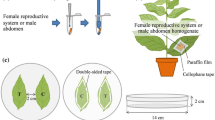Abstract
Torymus sinensis Kamijo (Hymenoptera: Torymidae) is a biological control agent of the chestnut gall wasp Dryocosmus kuriphilus Yasumatsu (Hymenoptera: Cynipidae). It is reported in the literature as univoltine, but in NW Italy it exhibits a prolonged diapause mainly as late instar larva. Diapause is extended for 12 months, and adults emerge in April as usual, showing a two-year life cycle. Second year emergence individuals are able to mate, and the presence of mature eggs was confirmed in females which parasitised fresh chestnut galls, showing the same parasitism behaviour as first year emergence individuals. Both sexes of second year emergence individuals proved to be smaller than the univoltine ones according to ovipositor sheath length, pronotum width, and hind tibia length. Proving evidence of the extended diapause plays an important role for the establishment of T. sinensis especially in the first years after its release. Future studies are needed to clarify the factors which trigger off this response.


Similar content being viewed by others
References
Belozerov VN (2008) Diapause and quiescence as two main kinds of dormancy and their significance in life cycles of mites and ticks (Chelicerata: Arachnida: Acari). Part 1. Acariformes. Acarina 16(2):79–130
Cooper WR, Rieske LK (2007) Community associates of an exotic gallmaker, Dryocosmus kuriphilus (Hymenoptera: Cynipidae), in Eastern North America. Ann Entomol Soc Am 100(2):236–244
Cooper WR, Rieske LK (2011) A native and an introduced parasitoid utilize an exotic gall-maker host. BioControl 56:725–734
Corley JC, Capurro AF, Bernstein C (2004) Prolonged diapause and the stability of host–parasitoid interactions. Theor Popul Biol 65:193–203
Danks HV (1987) Insect dormancy: an ecological perspective. Biological Survey of Canada Monograph Series No. 1. National Museum of Natural Sciences, Ottawa, Canada, 439 pp
Doutt RL, Annecke DP, Tremblay E (1976) Biology and host relationships of parasitoids. In: Huffaker CB, Messenger PS (eds) Theory and practice of biological control. Academic Press, New York, USA, pp 143–163
EFSA Panel on Plant Health (PLH) (2010) Risk assessment of the oriental chestnut gall wasp, Dryocosmus kuriphilus for the EU territory on request from the European Commission. EFSA J 8:1619
Geisert RW, Meinke LJ (2013) Frequency and distribution of extended diapause in Nebraska populations of Diabrotica barberi (Coleoptera: Chrysomelidae). J Econ Entomol 106(4):1619–1627
Hanski I (1988) Four kinds of extra long diapause in insects—a review of theory and observations. Ann Zool Fenn 25:37–53
Kaartinen R, Stone GN, Hearn J, Lohse K, Roslin T (2010) Revealing secret liaisons: DNA barcoding changes our understanding of food webs. Ecol Entomol 35:623–638
Kraaijeveld AR, van Alphen JJM (1995) Variation in diapause and sex ratio in the parasitoid Asobara tabida. Entomol Exp Appl 74:259–265
Leather ER, Walter KFA, Bale JS (1993) The ecology of insect overwintering. Cambridge University Press, Cambridge, UK
Lees AD (1955) The physiology of diapause in arthropods. Cambridge University Press, Cambridge, UK, 150 pp
Mahdjoub T, Menu F (2008) Prolonged diapause: a trait increasing invasion speed? J Theor Biol 251(2):317–330
Matsuo Y (2006) Cost of prolonged diapause and its relationship to body size in a seed predator. Funct Ecol 20:300–306
Menu F (1993) Strategies of emergence in the chestnut weevil Curculio elephas (Coleoptera: Curculionidae). Oecologia 96:383–390
Ming-Xing L, Shuang-Shuang C, Yu-Zhou D, Zhong-Xian L, Pingyang L, Jianyong L (2013) Diapause, signal and molecular characteristics of overwintering Chilo suppressalis (Insecta: Lepidoptera: Pyralidae) Sci Rep 3:3211
Moraiti CA, Nakas CT, Papadopoulos NT (2012) Prolonged pupal dormancy is associated with significant fitness cost for adults of Rhagoletis cerasi (Diptera: Tephritidae). J Insect Phys 58:1128–1135
Moraiti CA, Nakas CT, Papadopoulos NT (2014) Diapause termination of Rhagoletis cerasi pupae is regulated by local adaptation and phenotypic plasticity: escape in time through bet-hedging strategies. J Evol Biol 27(1):43–54
Moriya S, Inoue K, Ôtake A, Shiga M, Mabuchi M (1989) Decline of the chestnut gall wasp population, Dryocosmus kuriphilus Yasumatsu (Hymenoptera: Cynipidae) after the establishment of Torymus sinensis Kamijo (Hymenoptera: Torymidae). Appl Entomol Zool 24:231–233
Moriya S, Shiga M, Adachi I (2003) Classical biological control of the chestnut gall wasp in Japan. In: van Driesche RG (ed) Proceedings of the 1st international symposium on biological control of arthropods. USDA Forest Service, Washington, USA, pp 407–415
Piao CS, Moriya S (1999) Oviposition of Torymus sinensis Kamijo (Hymenoptera: Torymidae) under natural conditions. Entomol Sci 2(3):329–334
Quacchia A, Moriya S, Bosio G, Scapin G, Alma A (2008) Rearing, release and settlement prospect in Italy of Torymus sinensis, the biological control agent of the chestnut gall wasp Dryocosmus kuriphilus. BioControl 53:829–839
Ringel MS, Rees M, Godfray HCJ (1998) The evolution of diapause in a coupled host–parasitoid system. J Theor Biol 194:195–204
Schmidt PS, Matzkin L, Ippolito M, Eanes WF (2005) Geographic variation in diapause incidence, life-history traits, and climatic adaptation in Drosophila melanogaster. Evolution 59:1721–1732
Soula B, Menu F (2003) Variability in diapause duration in the chestnut weevil: mixed ESS, genetic polymorphism or bet-hedging? Oikos 100(3):574–580
Suez M, Gidoin C, Lefèvre F, Candau J-N, Chalon A, Boivin T (2013) Temporal population genetics of time travelling insects: a long term study in a seed-specialized wasp. PLoS ONE 8:e70818
Velarde RAM, Wiedenmann RN, Voegtlin DJ (2002) Influence of photoperiod on the overwintering induction of Galerucella calmariensis L. BioControl 47:587–601
Waldbauer GP (1978) Phenological adaptation and the polymodal emergence patterns of insects. In: Dingle H (ed) Evolution of Insect Migration and Diapause. Springer, New York, USA, pp 127–144
Acknowledgments
We wish to thank Johann Laimer who kindly provided the unparasitised chestnut galls used in the behavioural trials. We are also grateful to Michalis Bourellas, Marida Corradetti, Silvia Di Stefano, Cecilia Ferrara, Federica Fleury, and Valentina Tosi for their technical assistance. We are grateful to the anonymous reviewers for their constructive comments, which helped to substantially improve the manuscript.
Author information
Authors and Affiliations
Corresponding author
Additional information
Handling Editor: Stefano Colazza.
Rights and permissions
About this article
Cite this article
Ferracini, C., Gonella, E., Ferrari, E. et al. Novel insight in the life cycle of Torymus sinensis, biocontrol agent of the chestnut gall wasp. BioControl 60, 169–177 (2015). https://doi.org/10.1007/s10526-014-9633-4
Received:
Accepted:
Published:
Issue Date:
DOI: https://doi.org/10.1007/s10526-014-9633-4




